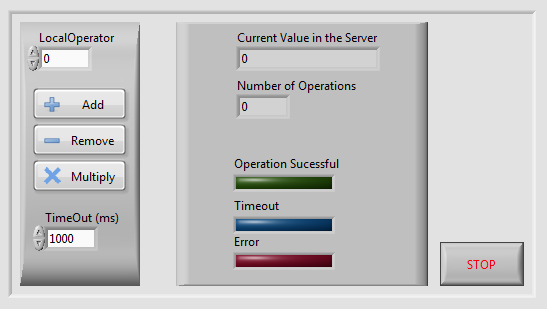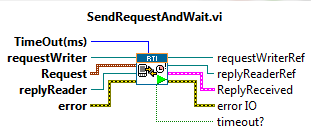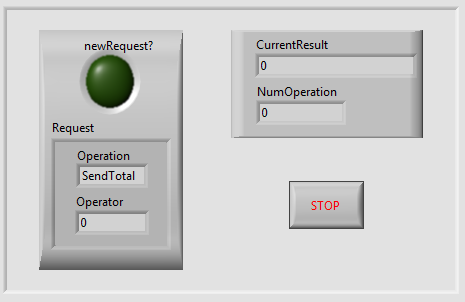How to use Request/Reply communication pattern in LabVIEW RTI DDS Toolkit for LabVIEW
This solution is only a workaround until the Request/Reply API is available in LabVIEW. This will only work for one Requester and one Replier.
The Request/Reply communication pattern is pretty useful for industrial applications. It is quite normal to have an application requesting an action to another one and waiting for a response (requester role).
RTI Connext provides a Request/Reply API for many languages. However, that API is not available in LabVIEW yet. To work around this limitation, we can develop our own Request/Reply application.
The current solution will only work in a one-to-one Request/Reply situation. This means that only one Requester and one Replier are allowed.
Example code requires LabVIEW 2013 SP1 or later and RTI DDS Toolkit for LabVIEW 1.1.0.88
Example application: Remote calculator
In the example provided, we have created a distributed calculator. The requester will send a numeric operation and an operator. The replier will do the operation between a sent operator and it's current value. Then, it will send the result back in the reply.
We are going to define our requests as an operation and an operator. Our reply, on the other hand, is going to be composed of an operation number, a flag indicating whether the operation was success or not, and the result of the operation if successful.


In the application, therefore, we have two main components:
Requester
This application (RequesterMain.vi) will request for a numeric operation to be computed in the replier side and wait for its response. Since the replier may not be alive, we need to provide a timeout time.

The requester is composed of a Writer of requests and a Reader of replies. Thus, in the subVIEW CreateRequester we return a reference to each of them:

In the main loop of the requester, whenever an operation button is clicked, we will create a new request and send it to the replier. To do this, we use the Event Structure from LabVIEW and we associate it with the "Value Change" of all operation buttons. Then, we use the Case Structure to select the operation depending on the button text and use that to create the request.
Once we have the request, we send it to the replier and wait for a response for a given time using the subVI (SendRequestAndWait.vi):

To end the execution, click stop. This will release all the resources used (requestWriter, replyReader and other internal DDS entities, for instance).
There is a very important detail to take into account, when we send a DDS request, it could live forever in the Writer queue, depending on its durability. If we send a request and the replier is not available, i.e. we need to wait longer than the time out, we should make sure that the request is deleted from the Writer queue. Otherwise, it could be sent to a late joiner request Reader and produce and unwanted result. In other words, we need to modify the durability of our requester DataWriter to be volatile. In the XML file provided, we have declared the following QoS:
<!-- Profile to be used with the RequestReply example-->
<qos_profile name="TimeOutReliableProfile" base_name="ReliableProfile">
<datawriter_qos>
<durability>
<kind>VOLATILE_DURABILITY_QOS</kind>
</durability>
</datawriter_qos>
</qos_profile> Since strict Reliability is not currently supported by the RTI DDS Toolkit for LabVIEW, we have also defined a ReliableProfile in our QoS. See this post to learn how to load a personalized QoS profile from LabVIEW.
Replier Application
This application will wait until a new request is received. Then, it will compute the operation between the current value stored locally and the operator sent. If the operation is success, it will send the result, a flag indicating success and the number of operations executed until the moment.

In this case, we need to create a Reader of requests and a Writer of replies.

It is important to make sure that the type name is the same between the request's Reader and Writer and between the reply's ones. In this example we have take care of this inside the Create subVIs.
In the main loop, we will have two parts. First, we will wait for a new request using ReadRequest.vi.

Then, whenever a new request is received, we perform the operation and reply using SendReply.vi. After that, we will go back to wait for a new request.

To end the execution, click stop. This will release all the resources used (requestWriter, replyReader and other internal DDS entities, for instance).

Comments
Shivam
Tue, 11/29/2016 - 15:12
Permalink
Can't find folder _internal_deps
Hey guys!
I'm trying to use this example in LabVIEW 2016 and it can't find the internal_deps folder. I'm using Windows 10 and RTI DDs Toolkit for LabVIEW 1.4.0.94.
Has anyone faced this problem before?
Thanks!
Shivam
angel
Wed, 11/30/2016 - 03:54
Permalink
Hi Shivam,You can find this
Hi Shivam,
You can find this folder in the next location: "<LabVIEW 2016 installation path>\vi.lib\_RTI DDS Toolkit for LabVIEW_internal_deps" .For instance C:\Program Files (x86)\National Instruments\LabVIEW 2016\vi.lib\_RTI DDS Toolkit for LabVIEW_internal_deps.
I hope the above is useful to you.
Angel.
Shivam
Wed, 11/30/2016 - 08:16
Permalink
Hi Angel, Thanks for the
Hi Angel,
Thanks for the response! I looked in exactly that folder and it's not there. I see only three folders, Library, Types, VIs, and the license file. I'll try uninstalling and reinstalling though.
EDIT:
Yup, reinstalled and the requisite folder still isn't there. Wonder what's going on...
angel
Thu, 12/01/2016 - 07:31
Permalink
Hi Shivam,In the path "
Hi Shivam,
In the folder "<LabVIEW 2016 installation path>\vi.lib\" there are two RTI folders. One called "RTI DDS Toolkit for LabVIEW" which contains the three folders that you mention, and another one called "_RTI DDS Toolkit for LabVIEW_internal_deps". Note that the second one starts with an underscore "_". This folder contains the libraries used by the RTI DDS Toolkit.
I hope this can fix your issue.
Angel.
Shivam
Thu, 12/01/2016 - 16:15
Permalink
yup, I was looking in the
Sorry Angel - I've located the right directory - however it's looking for the file lvdds.1.0.dll and that file is not there. Any other suggestions? I tried to point the file to rtilvdds.dll but no luck
angel
Fri, 12/02/2016 - 04:56
Permalink
Hi Shivam,The name of the
Hi Shivam,
The name of the library changed to rtilvdds.dll, also the refnum type was changed, and a couple of more things. I have updated this example. Please download it again and let me know if this works. Bear in mind that we need to load the custom QoS, hera a KB about how to do this: http://community.rti.com/kb/how-can-i-load-personalized-qos-profile-rti-dds-toolkit-labview
I hope now you can run this example.
Regards,
Angel.
Shivam
Tue, 12/06/2016 - 09:57
Permalink
Works great Sara. Thanks so
Works great Sara. Thanks so much!
sachsm
Mon, 04/30/2018 - 18:32
Permalink
Will RTI be releasing a built
Will RTI be releasing a built-in request/reply function to the LV toolkit? Also would it be too much to ask for user event notification as well?
leej
Wed, 05/09/2018 - 10:06
Permalink
Hi,We don't have immediate
Hi,
We don't have immediate plans for release built-in support for request/reply in the LabVIEW Toolkit, but it is being considered in our roadmap.
Can you provide more detail/color on your needs & ideas for user event notification?
Thanks.
- Lee
jkuehn
Tue, 01/07/2020 - 09:51
Permalink
Broken in LV 2018 Rev 3.0.0
Can you please update this example for LabVIEW 2018 RTI version 3.0.0?
Thank you.